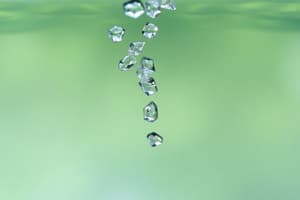Podcast
Questions and Answers
What type of medium do soaps form in water that aids in cleaning?
What type of medium do soaps form in water that aids in cleaning?
- A basic solution reduces surface tension.
- An acidic solution that dissolves dirt.
- A crystalline suspension that traps impurities.
- A colloidal medium that degreases and coagulates dirt. (correct)
Which characteristic differentiates permanent hardness from temporary hardness in water?
Which characteristic differentiates permanent hardness from temporary hardness in water?
- Temporary hardness cannot be removed by boiling.
- Temporary hardness is removed by soda, permanent hardness by lime
- Permanent hardness is caused only by calcium salts.
- Permanent hardness is thermally stable. (correct)
What is the purpose of converting the hardness of water salts into equivalents of $CaCO_3$?
What is the purpose of converting the hardness of water salts into equivalents of $CaCO_3$?
- To fit it into a standard scale for expressing hardness. (correct)
- To measure the exact quantities of calcium and magnesium.
- To simplify the process of removing hardness.
- To determine the exact amount of lime needed for water softening.
Which unit of hardness is equivalent to 1 part of $CaCO_3$ per 70,000 parts of water?
Which unit of hardness is equivalent to 1 part of $CaCO_3$ per 70,000 parts of water?
Which of the following ranges of ppm indicates moderately hard water?
Which of the following ranges of ppm indicates moderately hard water?
In the lime-soda process, what determines whether it is classified as a cold or hot process?
In the lime-soda process, what determines whether it is classified as a cold or hot process?
Which statement accurately describes the role of lime and soda in the cold lime-soda process?
Which statement accurately describes the role of lime and soda in the cold lime-soda process?
Which chemical reaction is primarily responsible for the removal of temporary hardness when lime is added to water?
Which chemical reaction is primarily responsible for the removal of temporary hardness when lime is added to water?
What is the main function of the ion-exchange process in water softening?
What is the main function of the ion-exchange process in water softening?
What type of material is commonly used as the ion exchanger in the cation exchange process for water softening?
What type of material is commonly used as the ion exchanger in the cation exchange process for water softening?
What is the purpose of treating the zeolite bed with brine solution (NaCl) in the ion-exchange process?
What is the purpose of treating the zeolite bed with brine solution (NaCl) in the ion-exchange process?
Why is it important to remove turbidity and colored substances from water before using it in an ion-exchange softener?
Why is it important to remove turbidity and colored substances from water before using it in an ion-exchange softener?
What is the key characteristic of a double exchange process (demineralization or deionization) compared to a single cation exchange process?
What is the key characteristic of a double exchange process (demineralization or deionization) compared to a single cation exchange process?
Which functional group is typically found in cation exchange resins used in demineralization?
Which functional group is typically found in cation exchange resins used in demineralization?
According to the provided text, what steam pressure would necessitate the use of softening techniques essential for high-pressure boilers?
According to the provided text, what steam pressure would necessitate the use of softening techniques essential for high-pressure boilers?
What is a significant disadvantage of using the hot lime-soda process for water softening?
What is a significant disadvantage of using the hot lime-soda process for water softening?
Why is the removal of hardness generally not undertaken for water that is already considered ‘soft’?
Why is the removal of hardness generally not undertaken for water that is already considered ‘soft’?
How does the hot lime-soda process accelerate the production of $CaCO_3$ and $Mg(OH)_2$ from their salts?
How does the hot lime-soda process accelerate the production of $CaCO_3$ and $Mg(OH)_2$ from their salts?
What role does NaOH play in the hot lime-soda process, and how is it produced?
What role does NaOH play in the hot lime-soda process, and how is it produced?
What advantage does the hot lime-soda process offer over the cold lime-soda process?
What advantage does the hot lime-soda process offer over the cold lime-soda process?
Flashcards
Soap
Soap
Salts of long-chain fatty acids (e.g., palmitic, oleic, or stearic acids) that form a colloidal medium in water to degrease and coagulate dirt.
Temporary Hardness
Temporary Hardness
Hardness caused by thermally unstable bicarbonates of calcium and magnesium; also known as 'Carbonate hardness'.
Permanent Hardness
Permanent Hardness
Hardness that shows thermal stability, unlike temporary hardness; can be eliminated by using lime and soda.
Scale of Hardness
Scale of Hardness
Signup and view all the flashcards
Parts per million (ppm)
Parts per million (ppm)
Signup and view all the flashcards
Degree Clarke (°Cl)
Degree Clarke (°Cl)
Signup and view all the flashcards
Degree French (°Fr)
Degree French (°Fr)
Signup and view all the flashcards
Softening of Hard Water
Softening of Hard Water
Signup and view all the flashcards
Lime-Soda (L-S) Process
Lime-Soda (L-S) Process
Signup and view all the flashcards
Hot Lime-Soda Process
Hot Lime-Soda Process
Signup and view all the flashcards
Ion-Exchange Process
Ion-Exchange Process
Signup and view all the flashcards
Zeolites
Zeolites
Signup and view all the flashcards
Working Procedure
Working Procedure
Signup and view all the flashcards
Regeneration
Regeneration
Signup and view all the flashcards
Double Exchange Process
Double Exchange Process
Signup and view all the flashcards
Anion Exchange Resin
Anion Exchange Resin
Signup and view all the flashcards
Organic Polymers
Organic Polymers
Signup and view all the flashcards
Study Notes
Soap
- Soap is a sodium or potassium salt of long chain fatty acids like palmitic, oleic, or stearic acids
- They form a colloidal medium in water that degreases fibers, coagulates dirt, and dislodges particles by jerking clothes
- Calcium (Ca2+) and magnesium (Mg2+) salts react with soap, rendering it unavailable for washing
Types of Hardness
- Hardness in water is due to the presence of Ca and Mg salts, classified into two types, depending on the chemical behavior
Temporary Hardness
- Caused by thermally unstable bicarbonates of Ca and Mg, also known as 'Carbonate hardness'
- Decomposition on heating:
- Ca(HCO3)2 decomposes into CaCO3, CO2, and H2O when heated
- Mg(HCO3)2 decomposes into Mg(OH)2 and CO2 when heated
- Lime treatment eliminates temporary hardness like this
- Ca(HCO3)2 reacts with Ca(OH)2 to form CaCO3 and H2O
- Mg(HCO3)2 reacts with Ca(OH)2 to form Mg(OH)2, CaCO3, and H2O
Permanent Hardness
- Exhibits thermal stability unlike temporary hardness, but can be eliminated by lime and soda
- Reactions involved:
- CaCl2 reacts with Na2CO3 to form CaCO3 and NaCl
- MgCl2 reacts with Na2CO3 to form MgCO3 and NaCl
- MgCO3 is soluble in water and contributes to hardness, but lime removes it, as it reacts with Ca(OH)2 to form Mg(OH)2 and CaCO3
- Notes on hardness removal:
- Temporary Ca-hardness is removed using one equivalent of lime
- Temporary Mg-hardness is removed using two equivalents of lime
- Permanent Ca-hardness is removed using one equivalent of soda
- Permanent Mg-hardness is removed by one equivalent of lime and soda
Scale of Hardness
- Hardness is expressed in 'CaCO3 scale,' where salts are converted into equivalents of CaCO3
- Formula for calculating hardness in CaCO3 scale:
- (Mass of hardness producing substance × 50) / Equivalent mass of hardness producing substance
- This also equals "No. of equivalents of hardness producing substance × 50"
- Example: Hardness caused by 38 mg/l of MgCl2 equals 40 mg/l of CaCO3
- Whenever hardness is reported, the value should be followed by 'of CaCO3'
Units of Hardness
- Commonly used units to express hardness:
- Parts per million (ppm): International unit
- 1 ppm of hardness equals 1 part of CaCO3 equivalent in 10^6 parts of water
- 1 mg/l = 1 ppm (since 1 ml of water weighs ≈ 1 g)
- Degree Clarke (°Cl): British unit
- 1 °Cl of hardness equals 1 part of CaCO3 equivalent in 70,000 parts of water
- Decree French (°Fr): French unit
- 1 °Fr of hardness equals 1 part of CaCO3 equivalent in 10^5 parts of water, equating to 10mg/l
- Parts per million (ppm): International unit
- Relationships between hardness units:
- 1 ppm ≈ 0.1 °Fr ≈ 0.07 °Cl
- 1 °Cl ≈ 14.3 ppm ≈ 1.43 °Fr
- 1 °Fr ≈ 10 ppm ≈ 10 mg/l ≈ 0.7 °Cl
- Equivalence in grams for various compounds related to hardness:
- 100 g of CaCO3 ≡ 162 g of Ca(HCO3)2 ≡ 146 g of Mg(HCO3)2
- 136 g of CaSO4
- 111 g of CaCl2
- 148 g of Mg(NO3)2 ≡ 44 g of CO2
- 2 g of H+
Degree of Hardness
- Approximate representation of hardness:
- 0-50 ppm is soft water.
- 50-100 ppm is moderately soft water.
- 100-150 ppm is moderately hard water.
- 150-250 ppm is hard water.
-
250 ppm is very hard water.
- Note: Hardness removal is preferred for moderately soft water or harder, but not for soft water (already soft) or very hard water (high sodium salt concentration).
Softening of Hard water
- It is the process of removing hardness from water, with methods like boiling, lime/Clarke process, lime-soda process, and ion-exchange
- Boiling or lime use shows minimal softening; lime-soda or ion-exchange are effective
- Combined methods yield better results
Lime-Soda (L-S) Process
- Both lime and soda are used as softening agents
- Lime-soda process variations:
- Cold lime-soda process: uses both lime and soda agents at room temperature
- Hot lime-soda process: uses only soda at higher temperatures
Cold Lime-Soda Process
- Operated at room temperature, employs two methods of operation:
- Intermittent Softening
- Continuous Softening
- Both lime and soda are used; generally, 10% excess chemicals are used for better softening
- Solubility limits of CaCO3 (~17ppm) and Mg(OH)2 (~15ppm) restrict residual hardness to 32ppm
- Temporary hardness reactions
- Ca(HCO3)2 + Ca(OH)2 => 2CaCO3↓ + 2H2O
- Mg(HCO3)2 + Ca(OH)2 => MgCO3 + CaCO3↓ + 2H2O
- MgCO3 + Ca(OH)2 => Mg(OH)2↓ + CaCO3↓
- Permanent hardness reactions
- CaCl2 + Na2CO3 => CaCO3↓ + 2NaCl
- MgCl2 + Na2CO3 => MgCO3 + 2NaCl
- MgCO3 + Ca(OH)2 => Mg(OH)2↓ + CaCO3↓
Reactions and Requirements of Lime and Soda for Softening
- Provides a table summarizing chemical reactions and equivalent requirements of lime and soda for softening different constituents of hardness
Lime Requirement
- Lime requirement = 74/100 [Temp. Ca + 2 x Temp. Mg + Perm (Mg + Fe + Al) + CO2 + H (free acid) + HCO3- - NaAlO2 in equiv. of CaCO3]
Soda requirement
- Soda requirement = 106/100 [perm (Ca + Mg + Al + Fe) + H+ (free acid) - HCO3- in equiv. CaCO3]
Intermittent Softener
- Consists of multiple large tanks for continuous water supply
- A small amount of alum is also mixed with lime and soda for effective separation of sludge within 2 hours
- The efficiency of the process depends upon mixing chemicals with water
- A horizontal stirrer operated by an externally placed motor is used to do this
- The bottom having a good slope effects easy separation and removal of sludge
- Residual hardness = 50 – 60 ppm (under optimum pH 8.5)
- Duration:
- In stepwise process it takes 15 mins. mixing, ~ 2 hours settling and rest sludge removal, supply and recharging total = 3 – 4 hours
Continuous Softener
- Usually smaller with a cylindrical tank
- Has a coaxial cylinder with a vertical stirrer
- The coaxial cylinder is fixed to the outer one by a filter bed consisting of synthetic fibrous material
- Water and chemicals are added from the top to the inner cylinder
- Precipitates separate and move to the bottom, while water moves upward through a filter bed
- Clear soft water is released through a valve.
Hot Lime-Soda Process
- Operates with water at 80-100°C with only soda
- Water and soda under spray and superheated steam (300°C)
- Reaction accelerates CaCO3 and Mg(OH)2 production from salts
Advantages of Hot Lime-Soda Process
- Faster reaction rate (10-15 mins) compared to cold process (2 hrs)
- Increased softening efficiency; residual hardness is 17-34 ppm versus 50-60 ppm in the cold process
- Coarse and heavy sludge separates easily
Hot Lime-Soda Process, Disadvantages
- The process may contaminate water with dissolved silica from alkaline medium filtration
- The alkaline water causes turbidity, which produces scale in boiler
- Heating increases production cost
- Requires careful operation and skilled supervision
- Produces a large amount of sludge
- Limited to a small quantity of water
- Residual hardness is unsuitable for boiler use, supplemented by ion-exchange for high-pressure boilers
Ion-Exchange Process
- The process replaces hardness-causing ions with non-hardness-producing ions, featuring a reaction between liquid and solid phases
- Two types of ion-exchange: cation exchange and double exchange (demineralization/deionization)
- Cation exchange uses a mobile ion with higher electropositivity to displace cations into the solid phase
- Occurring ion-exchangers called zeolites have a formula, Na2O • Al2O3 • xSiO2 • yH2O (x = 2-10, y = 2-6). Synthetic zeolites are also prepared
Cation Exchange Process
- The process can be written Na₂Ze (sodium zeolite where 'Ze' stands for O·Al2O3 ·xSiO2·yH2O)
- Reactions:
- Ca(HCO3)2 + Na2Ze -> CaZe + 2NaHCO3
- Mg(HCO3)2 + Na2Ze -> MgZe + 2NaHCO3
- CaCl2 + Na2Ze -> CaZe + 2NaCl
- MgCl2 + Na2Ze - MgZe + 2NaCl
- CaSO4 + Na2Ze -> CaZe + Na2SO4
- MgSO4 + Na2Ze -> MgZe + Na2SO4
- Due to sodium's electropositivity, Fe2+, Mn2+, and Al3+ ions are also removed
- Zeolites are large molecules forming a solid phase where cations pass and sodium ions are released
- Softening:
- Hard water is added from the top and passes down through the zeolite bed. Hard water softens and passes out through the outlet at the bottom.
- Regeneration:
- Zeolite is exhausted and needs regeneration after complete exhaust for further softening.
- Treatment with brine solution (10% NaCl solution) reverses the equilibrium reaction.
- Washing:
- During regeneration Ca and Mg chlorides form which are likely to stick to the system and reduce the strength of the exchangers.
Advantages of Ion-Exchange Process
- The residual hardness is 8-10 ppm
- The equipment is compact and occupies less space
- There is no precipitate and no sludge disposal problem
- The system adjusts automatically and it has less softening time
- Iron and manganese ions are also removed
Disadvantages of Ion-Exchange Process
- Turbidity can choke the filter bed.
- Substances like color, turbidity, acidity, alkalinity or Fe/Mn salts damages the zeolite.
- Zeolite dissolves in hot water.
- The softened water is only suitable for laundry but not for boilers
Double Exchange Process (Demineralisation or Deionisation)
- Used for water purification by eliminating all ions
- Two exchangers are used in series-cation exchanger, followed by anion exchanger
- Cation exchanges are high molecular weight, cross-linked polymer containing anionic and active mobile cation groups, while anion exchange resins contain amine or quanternary ammonium groups as bulky, inmobile cation
- Functional groups of synthetic ion-exchangers: strongly acidic/basic and weakly acidic/basic
- Acceptable hardness for boilers depends on operating stem pressure. Acceptable hardness decreases with increasing pressure
Organic Polymers
- Organic Polymer treated with concentrated sulfuric acid produces a sulfonic acid of the polymer.
- Organic Polymer + H2SO4 → Sulfonated organic polymer + H2O
Operational Procedure and key information
- High exchange capacity is exhibited by both hydrogen and sodium cycles
- Highly basic/weakly basic regenerations are achieved using caustic soda/ammonium hydroxide
Anion Exchanger
- A weakly basic ion-exchanger exchanges strong acids (Cl-, SO42-, NO3-) but not weak anions
- Strongly basic anion exchanger used for quick and efficient reaction There are issues with high pressure boilers employing the other exchanges
- Advantages: It caters to the is essential for high pressure boilers
- Disadvantage:
- Costly equipments are there
- Since super saturation with CaCO3 and Mg(OH2) leads to after precipitation, this is prevented by treating with excess lime and subsequent filtration by pressure filter prior to the ionexchange process.
Studying That Suits You
Use AI to generate personalized quizzes and flashcards to suit your learning preferences.




